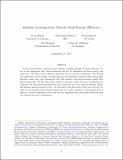| dc.description.abstract | In the United States, consumers invest billions of dollars annually in energy efficiency, often on the assumption that these investments will pay for themselves via future energy cost reductions. We study energy efficiency upgrades in K-12 schools in California. We develop and implement a novel machine learning approach for estimating treatment effects using high-frequency panel data, and demonstrate that this method outperforms standard panel fixed effects approaches. We find that energy efficiency upgrades reduce electricity consumption by 3 percent, but that these reductions total only 24 percent of ex ante expected savings. HVAC and lighting upgrades perform better, but still deliver less than half of what was expected. Finally, beyond location, school characteristics that are readily available to policymakers do not appear to predict realization rates across schools, suggesting that improving realization rates via targeting may prove challenging. | en_US |
